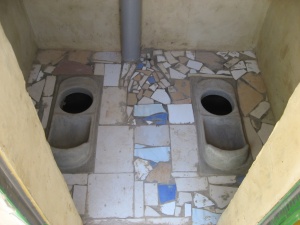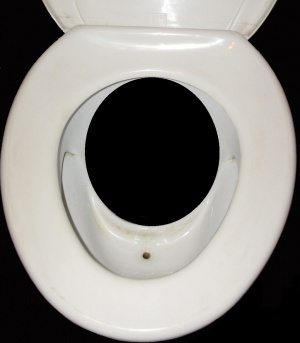Difference between revisions of "Composting toilet"
(→Urine) |
m (Spelling) |
||
| Line 24: | Line 24: | ||
==Urine== | ==Urine== | ||
| − | |||
| − | |||
| − | |||
Excessive ammonia from urine inhibits the microbial processes in the chamber. With urine diversion, less bulking agent is needed and the C/N ratio is naturally enhanced. | Excessive ammonia from urine inhibits the microbial processes in the chamber. With urine diversion, less bulking agent is needed and the C/N ratio is naturally enhanced. | ||
The C/N ratio of urine (1-1.3 L / person / day) is about 0.8 and its nitrogen content is ~15-18%.[http://www.weblife.org/humanure/chapter3_7.html] | The C/N ratio of urine (1-1.3 L / person / day) is about 0.8 and its nitrogen content is ~15-18%.[http://www.weblife.org/humanure/chapter3_7.html] | ||
| − | Urine can contain up to 90 percent of the nitrogen, up to 50 percent of the phosphorus, and up to 70 percent of the potassium present in human excreta.[http://www2.gtz.de/Dokumente/oe44/ecosan/en-fighting-urine-blindness-1998.pdf] In healthy individuals it is usually pathogen free, although undiluted it may contain inorganic salts and organic compounds at levels toxic to plants. | + | Urine can contain up to 90 percent of the nitrogen, up to 50 percent of the phosphorus, and up to 70 percent of the potassium present in human excreta.[http://www2.gtz.de/Dokumente/oe44/ecosan/en-fighting-urine-blindness-1998.pdf] In healthy individuals it is usually pathogen free, although undiluted it may contain inorganic salts and organic compounds at levels toxic to plants. |
| − | |||
| − | |||
Revision as of 16:18, 9 December 2014


It is estimated that the excreta from 80 persons could fertilize a hectare. A single adult eats 250 kg of cereals per year, which may be grown on less than 250 m2, fertilised by ~50% of the urine of that person, mixed with the waste water used by that person.[3]
Composting toilets aerobically decompose waste material, by aerobic microorganisms in a highly aerated, warm (32°-49°) and moist (humidity >80%) environment, with ample carbon (sawdust as the sole agent will lead to clogging[4]). During composting, mineralization, and humification occur simultaneously and are the main processes leading to degradation of the fresh organic matter. Organic matter humification in composting occurs when lignin and its degradation products are degraded by the microorganisms.[5] Optimally, the volume of the resulting compost may be about 10% of input.[6]
Continuous composting toilets are single container toilets that receive excrement which decomposes as it moves slowly through the container and is removed as compost from the end-product chamber. The container is permanently fitted under the toilet seat, and never has to be fully emptied as the compost can be gradually removed when it reaches the end-product chamber. [7] To make the fresh material move down the slope, the slope needs to be slippery, eg bathroom tiles.
In a non-urine-diverting system, 90% of what goes into a composting toilet is water. Compost piles need to be damp to work well, but most composting toilets suffer from too much water. (ideally 45 to 70% moisture content [8]) Ammonia may evaporate as nitrogen in a gas form, which is vented out along with carbon dioxide and water vapor.[9] Evaporation is the primary way a composting toilet gets rid of excess water. Warmth and air flow through the unit assist the evaporation process. Every composting toilet has a vertical vent pipe to carry off moisture. Air flows across the drying trays, around and through the pile, then up the vent to the outside of the building. In a cold environment, the low-grade heat produced by composting is supposed to provide sufficient updraft to carry vapor up the vent.[10] In tropical conditions, passive solar heating may create an air draft.
If operation conditions for thermophilic composting are adequate (moisture content 50 to 60%, carbon to nitrogen ratio 30 to 35 and mixing with bulking material), the temperature will rise to between 50 and 65 °C (WHO 2006). Such temperatures will effectively inactivate pathogens (WHO 2006).[11] If moisture content is too high, anaerobic organisms will thrive, creating undesirable odors from anaerobic digestion.
Carbon / Nitrogen ratio
Dry material, which contains carbon (such as dry leaves or grasses) increase composting properties. It regulates moisture and the carbon to nitrogen ratio (C/N) and enhances the composting process. The optimal carbon to nitrogen ratio for thermophilic composting is 20 to 35 (WHO 2006). The C/N ratio of humanure (135 to 270 g / person / day) is about 5 to 10 (5%-7% nitrogen) The C/N ratio of grass clippings may be 12-19 and they may contain 2.4% nitrogen. The C/N ratio of leaves may be 48 and they may contain 0.9% nitrogen.[12] Thus 200 g humanure plus 225 g leaves may render a combined C/N ratio of 30.
Crude protein in the leaves of Giant cane (Arundinaria gigantea) is relatively low in young leaves.[13] The C/N ratio in Giant cane leaves may be 19.4 (2.4% nitrogen and 45.8% carbon).[14] Bamboo shoots may contain 0.6% nitrogen. Overall bamboo litter (culm, branches, leaves) may contain 1.4% nitrogen.[15] The carbon concentration in decomposing bamboo culms may be 50%, irrespective of decomposition level. Mean nitrogen concentration may be 1%.(going up from ~0.3% as decomposition advances) [16] The C/N ratio of softwood may be 640, of hardwood may be 560 and that of sawdust 500, which goes down as it rots (down to 200).[17] That is because the level of carbon (and Na, K) goes down faster than the level of nitrogen (and P).[18] Nitrogen is usually retained until 50% of the carbon remains.[19] For the supply of carbon, one may process wood into sawdust, or one may let the chopped wood decompose naturally (with a lower C/N ratio). Assuming a C/N ratio of 200 in partially decomposed bamboo wood (Bamboo biochar and wood biochar have the same C/N ratio[20]), 200 g humanure + 200 g Giant cane leaves + 63 g partially decomposed bamboo wood yields a combined C/N ratio of 30. Assuming a C/N ratio of 50 in partially decomposed bamboo culms (1% N, 50% C), 200 g humanure + 200 g Giant cane leaves + 252 g partially decomposed bamboo culms yields a combined C/N ratio of 30.
Urine
Excessive ammonia from urine inhibits the microbial processes in the chamber. With urine diversion, less bulking agent is needed and the C/N ratio is naturally enhanced. The C/N ratio of urine (1-1.3 L / person / day) is about 0.8 and its nitrogen content is ~15-18%.[21] Urine can contain up to 90 percent of the nitrogen, up to 50 percent of the phosphorus, and up to 70 percent of the potassium present in human excreta.[22] In healthy individuals it is usually pathogen free, although undiluted it may contain inorganic salts and organic compounds at levels toxic to plants.
